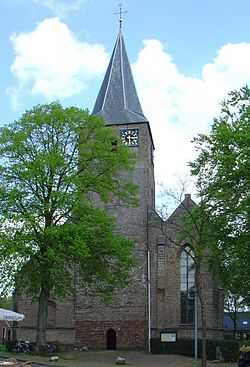Diever
| Diever | |
|---|---|
| Town | |
 | |
 | |
 | |
| Coordinates: 52°51′20″N 6°19′3″E / 52.85556°N 6.31750°ECoordinates: 52°51′20″N 6°19′3″E / 52.85556°N 6.31750°E | |
| Country | Netherlands |
| Province | Drenthe |
| Municipality | Westerveld |
| Population (1 January 2008)[1] | |
| • Total | 2,090 |
| Time zone | CET (UTC+1) |
| • Summer (DST) | CEST (UTC+2) |
Diever is a village in the Dutch province of Drenthe. It is a part of the municipality of Westerveld, and lies about 18 km northwest of Hoogeveen.
Diever is located near the Drentse Hoofdvaart, a major north-south route for pleasure boats in the province of Drenthe. Diever lies next to the Drents-Friese Wold, one of the major national parks in the Netherlands, and a major attraction for tourists.[citation needed] In the centre of Diever there is the brink, a square with old buildings surrounding it. The Dutch Reformed Saint Pancratius-church is a 15th-century building, and considered one of the most beautiful churches of Drenthe.
Diever was a separate municipality until 1998, when the new municipality of Westerveld was created.[2]
In 2001, the town of Diever had 1941 inhabitants. The built-up area of the town was 0.80 km², and had 810 residences.[3] The statistical area "Diever", which also can include the surrounding countryside, has a population of around 2580.[4]
Shakespeare
In July and August some of the local people of Diever perform in dramas written by William Shakespeare.[citation needed] Diever is also known as "Shakespeare-town".[citation needed] The plays are being performed in an open-air theater and are famous[citation needed] in the Netherlands. Even in Stratford-upon-Avon people apparently know that the local people of Diever perform in Shakespeare's plays.[citation needed] The local amateur theater group was formed in 1946 by a local medical doctor, Mr. Derp Broekema.[citation needed] Thus in 2006 we celebrated the 60th anniversary of this annual event with the performance of Henry IV.[citation needed]
References
- ↑ CBS Statline
- ↑ Ad van der Meer and Onno Boonstra, "Repertorium van Nederlandse gemeenten", KNAW, 2006.
- ↑ Statistics Netherlands (CBS), Bevolkingskernen in Nederland 2001. (Statistics are for the continuous built-up area).
- ↑ Statistics Netherlands (CBS), Statline: Kerncijfers wijken en buurten 2003-2005. As of 1 January 2005.
External links
- J. Kuyper, Gemeente Atlas van Nederland, 1865-1870, "Diever". Map of the former municipality in 1868.